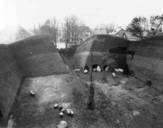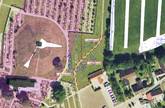- Steering group and management
- Sub-projects
- Jelling in GIS (Geographic Information System)
- Geophysical survey at Jelling
- Fieldwork 2011
- Archaeological fieldwork 2010
- Archaeological fieldwork 2009
- Jelling’s large stones
- The landscape around Jelling
- Place names in Jelling and its vicinity
- The bridge over Ravning Enge
- The travertine churches of East Jutland.
- Rune stones in context 2011
- Power and coins 2009
- Exhibitions
- Digitizing the photographs
Thyras Have 2009
In April-May 2009 an excavation is undertaken immediately east of the North Mound at Jelling with the aim of establishing the course of Scandinavia’s largest ship-setting. In 2006 and 2007 Vejle Museum uncovered a number of large stones in the field north of the churchyard at Jelling. This encouraged speculation about a huge ship-setting. The locality of the investigation is named after Thyras Have, an old smallholding, which was previously situated here.
Earlier investigations
In 1861 King Frederik VII initiated an investigation of the South Mound at Jelling (Gorm’s mound) in the hope of finding Gorm the Old’s grave. This investigation proved fruitless. In 1941 the South Mound was again investigated, also without a positive result. Rather than a grave, two rows of megaliths were discovered, which had been placed their before the construction of the mound. In 1942 the North Mound was also excavated. The sequence of layers in the middle of the mound indicated that the Viking Age burial chambers had been dug down into a Bronze Age mound dating to around 2000 years earlier.
An investigation at the South Mound’s southern edge in 1992 supported the theory of a large ship-setting, around 170 metres in length. This began at the Bronze Age mound (the North Mound) and stretched to the south, with the tip lying south of the South Mound.
Objective
The stones from Vejle Museum’s investigations in 2006 and 2007 have been interpreted as the northern end of the ship-setting now measuring 350 metres in length, with the megaliths from 1941 making up the southern end. The objective of the investigation at Thyras Have is to expand knowledge of the supposed ship-setting and perhaps uncover further traces of features connected to the Jelling monuments.
Project coordinators: Museum Inspector Steen Wulff Andersen, Vejle Museum in cooperation with Assistant Professor Mads Kähler Holst, Aarhus University.




